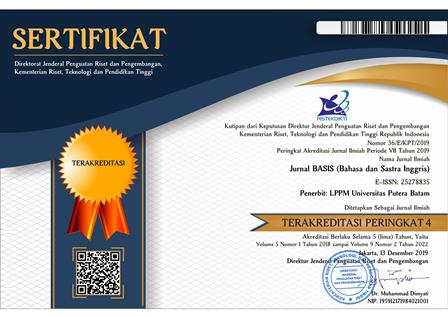SOCIAL CLASS CONFLICT REFLECTED IN “FAR FROM THE MADDING CROWD” NOVEL BY THOMAS HARDY
DOI:
https://doi.org/10.33884/basisupb.v7i2.2472Keywords:
sociological approach, social class conflict, social classAbstract
This research aimed to analyze social class conflict reflected in novel of Far from the Madding Crowd by Tomas Hardy. This descriptive qualitative research focuses on the social class conflict in England which is reflected in this novel. This study uses a sociological approach and analyzes the distribution of social classes in this novel and the social class conflicts that occur in this novel. The method used in writing this thesis is a qualitative descriptive method, namely the author describes, memorizes, and analyzes existing data. Quotations from books in libraries and the internet related to this research. The theory used is the theory of sociology with experts Max Weber and Karl Max.. The theory proposed by Karl Marx is an explicit theory, based on Marx's description of the laws of historical development, capitalism and socialism. Theory of sociology is used to analyze the social class divisions that exist in this novel while Maxisme class theory analyzes the conflicts. The results are have featured three male characters who became the main characters are Mr. Boldwood, Mr. Troy and Mr. Oak coming from three different classes of lower classes, middle classes, and upper classes. The social that happen among of three male character are: First, Bribery are shown conflict between Mr. Boldwood and Mr. Troy are representation to Upper Class and Middle Class. Second, Arrogance are shown conflict between Mr. Boldwood and Mr. Troy are representation to Middle Class and Upper Class. Third, are shown conflict between Mr. Troy and Mr. Oak are representation to Middle Class and Lower Class.
References
Anisa, Dwi Listi. Social class and Social Reality of British Society as reflected in Pride and Prejudice by Jane Austen; A Sociological Approach. 2012. Putera Batam University.
Arianto, T. (2017). Death as Instrument of Power in the novel My Sister Keeper by Jodi Picoult. Basis, 4(April 2017), 46–58. http://ejournal.upbatam.ac.id/index.php/basis/article/view/78
Arianto, T. (2019). The analysis of formula in the legend of japanese samurai rurouni kenshin and miyamoto mushasi: popular literary approach. Jurnal BASIS, 6(1), 55–64. https://doi.org/https://doi.org/10.33884/basisupb.v6i1.1047
Arianto, T., & Simanjuntak, D. S. (2019). Paradoxical Representation of Female Narration in the Spirit of Mak Ungkai StoryNo Title. Journal BASIS, 6(2), 173–184. https://doi.org/https://doi.org/10.33884/basisupb.v6i2.1413
Booker, M. K. dan Thomas, A. M. (2009). The science fiction handbook. Chichester: John Wiley and Sons
Dubois, W. E. B. (1996). Ladder for Booker T. Washington, 1996. 88–89.
Farida, Hana. (2020). Being Human Among Otherkins:Identifying The Simulacrum In Jrr Tolkien’s The Lord Of The Rings. Jurnal Basis, v. 7, n. 1, p. 81-90, apr. 2020. ISSN 2527-8835. Available at: http://ejournal.upbatam.ac.id/index.php/basis/article/view/1817
Hariyanti, Mei. 2013. Social Strafication Reflected at Jane Austen’s Pride and Prejudice Novel (1813); A Sociological Approach. Putera Batam University
Kuipers, B.S., Higgs, M.J., Kickert, W.J.M., Tummers, L.G., Grandia, J., dan Van der Voet, J. (2014). The Management of Change in Public Organizations : A Literature Review. International Journal of Public Administration.
Lexy.J. Moleong, Metodologi Penelitian Kualitatif Bandung : Remaja Roskakarya, 2000
Linda, L., & Arianto, T. (2018). Child Literature Genre Formulation in Walt Disney Animation Movie. Jurnal Basis, 5(2), 11. https://doi.org/https://doi.org/10.33884/basisupb.v5i2.776
Lofland dan Lofland dikutip oleh Dr.Lexy J Moleong, Metode Penelitian Kualitatif, Bandung : Rosdakarya, 2006
Londong, Pamela Clara. Literature that Reflected in Pride and Prejudice. Manado. Sam Ratulangi University. 2008
Max weber. (1978). Max Weber . (1922) 1978. 1922, 1978.
Sipahutar, R., & Arianto, T. (2019). An Analysis of Semiotic Riffaterre in Walt Whitman Selected Poem. Journal BASIS, 6(2), 237–248. https://doi.org/https://doi.org/10.33884/basisupb.v6i2.1428
Sudaryanto. 1993. Metode dan Aneka Teknik Analisis Bahasa ( Pengantar Penelitian Wahana Kebudayaan Secara Linguistis ). Yogyakarta: Duta Wacana University Press.
Stanton, Robert. 1965. An Introduction to Fiction. New York: Holt, Rinehart and Winston.
Sugiyono. 2011. Metode Penelitian Kuantitatif, Kualitatif dan R&D. Bandung: Afabeta
Suwondo, Tirto, dkk. 2006. Antologi Biografi Pengarang Sastra Modern. Yogyakarta: Adi Wacana.
Swingwood. Allan (n.d.). The Sociology of Literature. 1st November by Harper Collins. Retrieved from Max weber. (1978). Max Weber . (1922) 1978., (1922), 1978.
Waworuntu, M. I. G. R., & Arianto, T. (2019). Hibridity of the Characters in My Son The Fanatic Short Story by Hanief Kureshi. BASIS UPB, 6, 197–208. https://doi.org/https://doi.org/10.33884/basisupb.v6i2.1432
Wellek, R., & Warren, A. (1956). Theory of literature [by] René Wellek and Austin Warren. New York: Harcourt, Brace & World.
Downloads
Published
Issue
Section
License

















